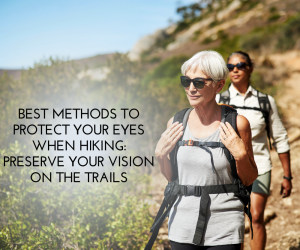
Choose Quality Sunglasses for Eye Protection:
The first line of defense against harmful ultraviolet (UV) rays and glare is a pair of high-quality sunglasses. Look for sunglasses that offer 100% UV protection and block both UVA and UVB rays. Additionally, consider sunglasses with polarized lenses to reduce glare from surfaces like water, snow, or rocky terrains. A good fit and wrap-around design will provide optimal coverage, shielding your eyes from all angles.
Wear a Wide-Brimmed Hat or Cap:
Complementing your sunglasses, a wide-brimmed hat or cap provides an extra layer of protection against direct sunlight. By creating shade and reducing the amount of UV radiation reaching your eyes, a hat acts as a barrier from harmful rays. Opt for a hat with a wide brim that extends at least three inches all around, effectively shielding your eyes, face, and neck.
Use Protective Eyewear in Hazardous Environments:
Certain hiking trails may expose you to potential eye hazards, such as branches, thorns, or flying debris. In such environments, it is crucial to wear protective eyewear, such as safety goggles or sports glasses. These specialized eyewear options are designed to withstand impact and provide a shield against debris, reducing the risk of eye injuries.
Keep Your Eyes Hydrated:
Hiking in dry and arid climates or at high altitudes can lead to dry eyes, causing discomfort and potentially damaging your vision. Stay hydrated by drinking an adequate amount of water throughout your hike. Additionally, consider using lubricating eye drops to keep your eyes moist and prevent dryness and irritation. Consult with an eye care professional to find the right eye drops for your specific needs.
Take Regular Breaks and Blink Frequently:
When hiking for extended periods, your eyes can become fatigued and strained. To alleviate eye strain, make it a habit to take regular breaks and relax your eyes. Focus on a distant object to exercise your long-range vision and reduce strain. Furthermore, remember to blink frequently to keep your eyes lubricated and prevent dryness, especially when staring at screens on your breaks.
Be Mindful of Altitude-Related Eye Concerns:
If you’re hiking at high altitudes, be aware of altitude-related eye conditions such as acute mountain sickness (AMS) and high altitude retinal hemorrhage (HARH). These conditions can cause blurred vision, eye pain, and, in severe cases, vision loss. To minimize the risk, acclimatize properly, stay well-hydrated, and consider using eye drops recommended by a healthcare professional.
When preparing for a hike, safeguarding your eyes should be a top priority. By following these best methods to protect your eyes when hiking, you can mitigate the risk of eye damage, enjoy the beauty of nature, and preserve your vision for years to come. Remember to invest in quality sunglasses, wear a wide-brimmed hat or cap, use protective eyewear in hazardous environments, keep your eyes hydrated, take regular breaks, and be mindful of altitude-related eye concerns. Prioritizing eye protection ensures a safe and enjoyable hiking experience while maintaining optimal eye health.
For more information contact Optik Birmingham today!


